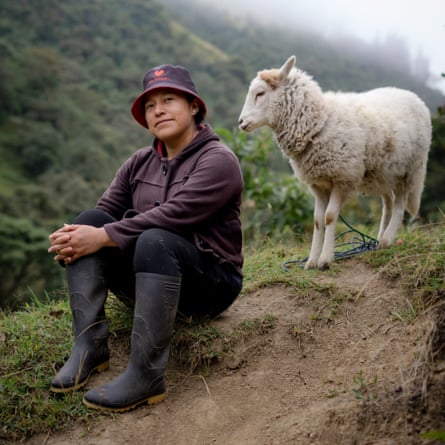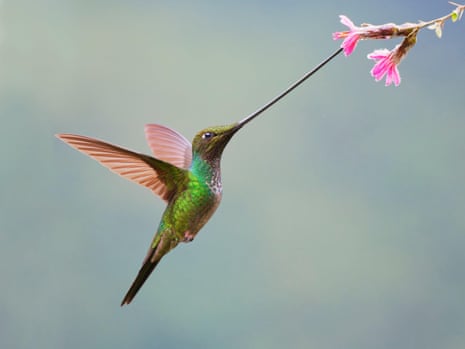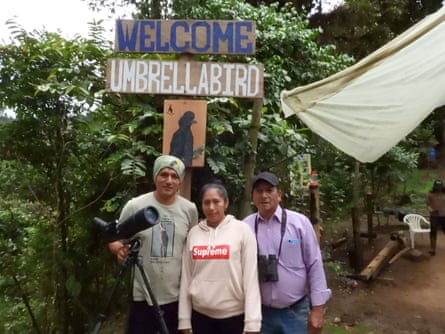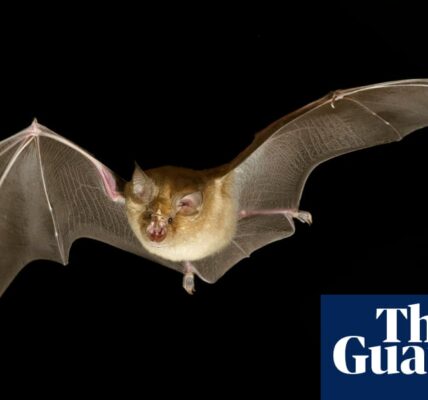‘More profitable than farming’: how Ecuador’s birding boom is benefiting wildlife
When it came to dividing up his late father’s farm between five brothers, Vinicio Bacuilima says he drew the short straw. Maraksacha, on the main road out of Ecuador’s capital Quito, is a tiny patch of land on the edge of a steep ravine, making it very difficult to make a living from farming.
Then Bacuilima’s wife Anita Cajas had an idea: turn their paltry inheritance into a site to attract visiting birders. Creating the Maraksacha Reserve was a risky venture, but it paid off, with feeders attracting a host of colourful hummingbirds and tanagers.
“Because we’re on the main road from Quito to Mindo, we get lots of visitors – especially bird photographers,” Cajas says. They “enjoy sitting on our terrace, drinking coffee, and getting such closeup views of the birds”.

Birding tourism is thriving in Ecuador, with increasing numbers of specialist tour groups, local bird guides and wildlife lodges. The country boasts more than 1,600 different species – almost twice as many as the whole of Europe – in an area only slightly larger than the UK. As the business of birding grows, more and more subsistence farmers are transitioning their land from agriculture to bird reserves, benefiting not just the birds, but the country’s economy too.
Angie Drake, a sustainable tourism consultant in the US, says by improving biodiversity and reaching out to wildlife tourists, some farmers have expanded their land’s potential far beyond the traditional farming model.
“They are finding ways to balance profitability with environmental stewardship,” she says. “This innovative approach offers a blueprint for other farmers wanting to reconsider their relationship with the land.”
One family, the Avilas, have devoted their lives to saving one of South America’s most bizarre species: the long-wattled umbrellabird. This black, crow-like species sports a teddy boy’s quiff and what looks like a long, woollen scarf hanging down from its throat. On his land near Recinto 23 de Junio, landowner Luis Avila has switched from dairy farming to conservation, replanting trees and promoting the site to wildlife tourists – work that he says is a better livelihood than farming.

“Wildlife tourism is far more profitable than farming but that’s not the only reason we made the change,” says Avila’s son, Luis Jr. “We wanted to save not just the umbrellabird, but all the special creatures here, and safeguard them for future generations.”
Projects such as this are eligible for funding from the Ecuadorian government. Launched in 2008, the Socio Bosque scheme offers “the poorest private and communal forest landowners annual payments for each hectare of forest cover maintained”, with sums of between $30 (£23) and $60 a hectare.
However, the application process is complex and funding can be sporadic, so some landowners – including Bacuilima and Cajas – have given up applying.

But the income provided by birders alone has been enough to propel some farmers to take up the nature reserve model. A few years ago, Favián Luna decided to convert his 120-hectare tomato farm in the Tandayapa Valley, north-west of Quito, into a cloud-forest reserve and lodge called Alambi Reserve. Visitors go to photograph many species of hummingbirds, including the Andean emerald, native to the Chocó bioregion of the Ecuadorian Andes.
Nearby, at Mashpi Amagusa, former farmers Doris Villalba and Sergio Basantes have created a reserve, lodge and garden, which attracts 260 species of sought-after birds. Highlights include glistening-green, flame-faced and beryl-spangled tanagers, and the rare, endemic rose-faced parrot.
At Finca La Victoriana in Pichincha, the owner Jacqui bought the house and land, and began to reforest the site while growing crops to feed herself. But during lockdown, when she was stuck in nearby Quito, all her crops were stolen. She was saved from having to sell up by a visiting friend, who heard an unusual sound from lower down the valley and realised this was one of South America’s most charismatic birds: the Andean cock-of-the-rock.
The bright orange and black males gather every day at their “lek”, a courtship arena where they perform to the watching females.

Since 2005, Ángel Paz and his younger brother Rodrigo have transformed their former dairy farm in Mindo into a bird reserve. At first, things didn’t go to plan: it took a month for the first visitor to arrive, and he paid just $10 for a four-hour tour. Since then, however, thousands of people have made the pilgrimage.
Ángel has slowly habituated five species of antpitta – a notoriously elusive family of birds – to appear more or less on cue. He calls one female Shakira, because when she appears she shakes her hips from side to side.
Refugio Paz de las Aves became well known, yet it was nearly lost for ever. After the death of Ángel and Rodrigo’s mother, some of the siblings wanted to sell the site to local dairy farmers.
A global crowdfunding appeal launched by Ángel’s son Vinicio with support from Drake raised $160,000 to buy the land, protecting the habitat for the foreseeable future.
For Ángel, success is about allowing wildlife the time to return and prosper. “My brother and I have protected our home and its birdlife for almost two decades, and watched the wildlife – and the people who visit – flourish,” he says. “For us, it’s all about making a connection with the unique species that live here.”

Find more age of extinction coverage here, and follow biodiversity reporters Phoebe Weston and Patrick Greenfield on X for all the latest news and features
Source: theguardian.com



